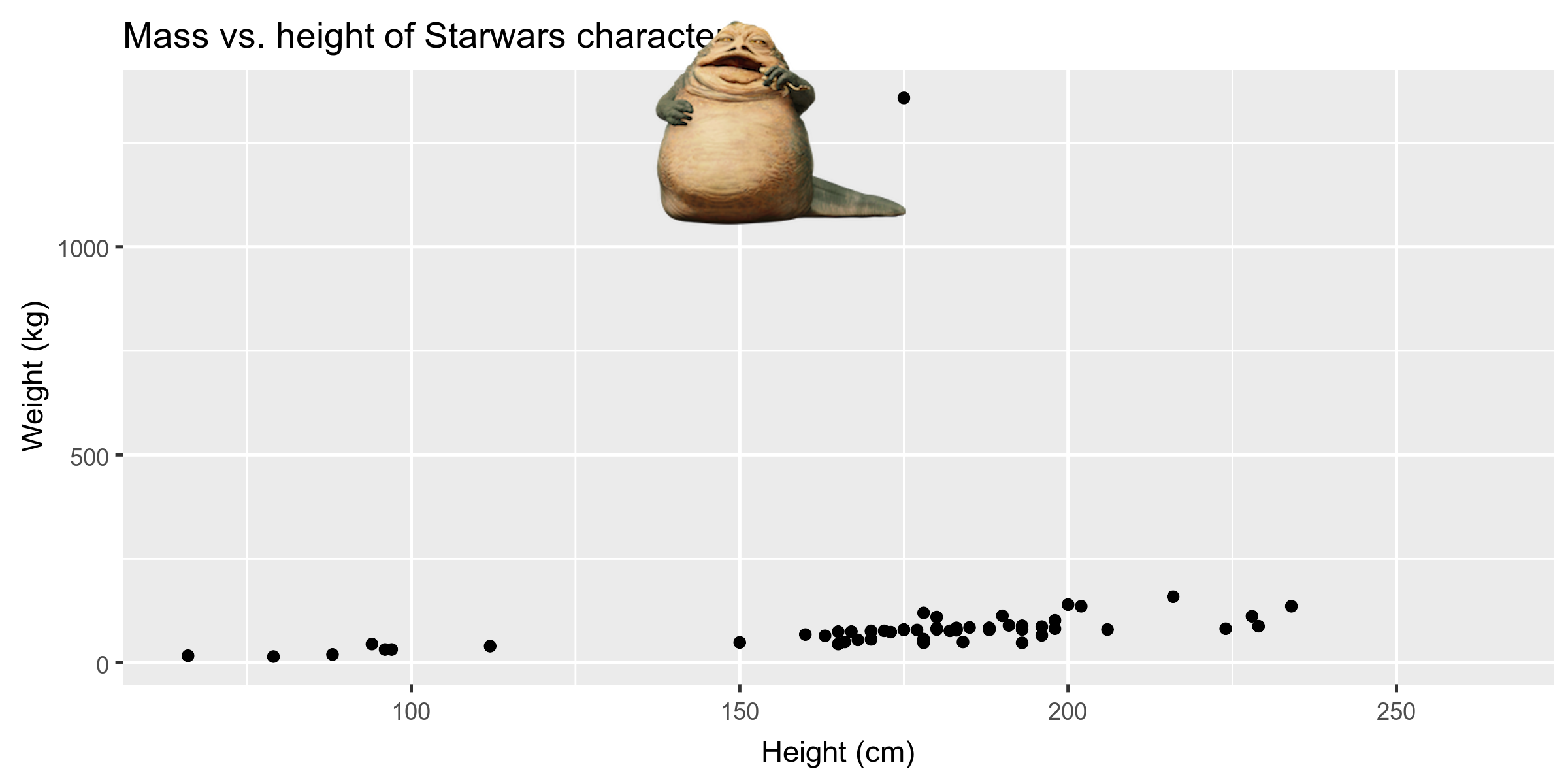Unusual Observations
1 / 25
Dr. Lucy D'Agostino McGowan
Starwars (2)
- Go to RStudio Cloud and open
Starwars (2)
2 / 25
Dr. Lucy D'Agostino McGowan
Definitions
How does your book define an "outlier"?
3 / 25
Dr. Lucy D'Agostino McGowan
Definitions
How does your book define an "influential point"?
4 / 25
Dr. Lucy D'Agostino McGowan

5 / 25
Dr. Lucy D'Agostino McGowan
Example
lm(mass ~ height, data = starwars)## ## Call:## lm(formula = mass ~ height, data = starwars)## ## Coefficients:## (Intercept) height ## -13.8103 0.63866 / 25
Dr. Lucy D'Agostino McGowan
Example
y_hat <- lm(mass ~ height, data = starwars) %>% predict()starwars %>% filter(!is.na(height) & !is.na(mass)) %>% mutate(residual = mass - y_hat) %>% ggplot(aes(y_hat, residual)) + geom_point() + geom_hline(yintercept = 0)
7 / 25
Dr. Lucy D'Agostino McGowan
Example
What does this line of code do?
y_hat <- lm(mass ~ height, data = starwars) %>% predict()starwars %>% filter(!is.na(height) & !is.na(mass)) %>% mutate(residual = mass - y_hat) %>% ggplot(aes(y_hat, residual)) + geom_point() + geom_hline(yintercept = 0)8 / 25
Dr. Lucy D'Agostino McGowan
Example
What does this line of code do?
y_hat <- lm(mass ~ height, data = starwars) %>% predict()starwars %>% filter(!is.na(height) & !is.na(mass)) %>% mutate(residual = mass - y_hat) %>% ggplot(aes(y_hat, residual)) + geom_point() + geom_hline(yintercept = 0)9 / 25
Dr. Lucy D'Agostino McGowan
Example
Is this an outlier?

10 / 25
Dr. Lucy D'Agostino McGowan
Example
Gold-medal-winning distances (m) for the men's Olympic long jump, 1900–2008

11 / 25
Dr. Lucy D'Agostino McGowan
Example
Gold-medal-winning distances (m) for the men's Olympic long jump, 1900–2008

12 / 25
Dr. Lucy D'Agostino McGowan
Example
Gold-medal-winning distances (m) for the men's Olympic long jump, 1900–2008

13 / 25
Dr. Lucy D'Agostino McGowan
How can we tell if a residual is "unusually" large?
14 / 25
Dr. Lucy D'Agostino McGowan
How can we tell if a residual is "unusually" large?
Do we have a "typical" error we can standardize by?
15 / 25
Dr. Lucy D'Agostino McGowan
Standardize residuals
- ˆσϵ: reflects the typical error
16 / 25
Dr. Lucy D'Agostino McGowan
Standardize residuals
- ˆσϵ: reflects the typical error
- residualˆσϵ
16 / 25
Dr. Lucy D'Agostino McGowan
Standardize residuals
- ˆσϵ: reflects the typical error
- residualˆσϵ
- y−ˆyˆσϵ
16 / 25
Dr. Lucy D'Agostino McGowan
Studentized residuals
- Another option is to estimate the standard deviation of the regression error using a model that is fit after omitting the point in question
17 / 25
Dr. Lucy D'Agostino McGowan
Studentized residuals
- Another option is to estimate the standard deviation of the regression error using a model that is fit after omitting the point in question
- In R:
rstudent()
17 / 25
Dr. Lucy D'Agostino McGowan
Example
What is model?
model <- lm(Gold ~ Year, data = LongJumpOlympics)18 / 25
Dr. Lucy D'Agostino McGowan
Example
model <- lm(Gold ~ Year, data = LongJumpOlympics) y_hat <- model %>% predict()19 / 25
Dr. Lucy D'Agostino McGowan
Example
model <- lm(Gold ~ Year, data = LongJumpOlympics) y_hat <- model %>% predict()y_hat <- lm(Gold ~ Year, data = LongJumpOlympics) %>% predict()19 / 25
Dr. Lucy D'Agostino McGowan
Example
model <- lm(Gold ~ Year, data = LongJumpOlympics) y_hat <- model %>% predict()y_hat <- lm(Gold ~ Year, data = LongJumpOlympics) %>% predict()LongJumpOlympics %>% mutate(y_hat = model %>% predict())19 / 25
Dr. Lucy D'Agostino McGowan
Example
model <- lm(Gold ~ Year, data = LongJumpOlympics)LongJumpOlympics %>% mutate(y_hat = model %>% predict(), stud_resid = model %>% rstudent())## Year Gold y_hat stud_resid## 1 1900 7.185 7.241150 -0.24969110## 2 1904 7.340 7.297413 0.18773767## 3 1906 7.200 7.325544 -0.55459469## 4 1908 7.480 7.353675 0.55605557## 5 1912 7.600 7.409938 0.83801927## 6 1920 7.150 7.522463 -1.69661296## 7 1924 7.445 7.578726 -0.57565964## 8 1928 7.730 7.634988 0.40587196## 9 1932 7.640 7.691251 -0.21761617## 10 1936 8.060 7.747514 1.37486325## 11 1948 7.825 7.916301 -0.38535068## 12 1952 7.570 7.972564 -1.80894501## 13 1956 7.830 8.028827 -0.84888005## 14 1960 8.120 8.085089 0.14690763## 15 1964 8.070 8.141352 -0.30102045## 16 1968 8.900 8.197615 3.76651449## 17 1972 8.240 8.253877 -0.05865636## 18 1976 8.350 8.310140 0.16903844## 19 1980 8.540 8.366402 0.74709891## 20 1984 8.540 8.422665 0.50367210## 21 1988 8.720 8.478928 1.05875652## 22 1992 8.670 8.535190 0.58546175## 23 1996 8.500 8.591453 -0.39790914## 24 2000 8.550 8.647716 -0.42816057## 25 2004 8.590 8.703978 -0.50378890## 26 2008 8.370 8.760241 -1.8537606720 / 25
Dr. Lucy D'Agostino McGowan
Example
model <- lm(Gold ~ Year, data = LongJumpOlympics)LongJumpOlympics %>% mutate(y_hat = model %>% predict(), stud_resid = model %>% rstudent()) %>% ggplot(aes(Year, stud_resid)) + geom_point() + geom_hline(yintercept = c(2, 4, -2, -4), lty = 2) + labs(y = "studentized residual")
21 / 25
Dr. Lucy D'Agostino McGowan
Influential points
Would removing the observation from the dataset change the regression equation by much?
22 / 25
Dr. Lucy D'Agostino McGowan
Example
lm(mass ~ height, data = starwars)## ## Call:## lm(formula = mass ~ height, data = starwars)## ## Coefficients:## (Intercept) height ## -13.8103 0.6386starwars %>% filter(name != "Jabba Desilijic Tiure") %>% lm(mass ~ height, data = .)## ## Call:## lm(formula = mass ~ height, data = .)## ## Coefficients:## (Intercept) height ## -32.5408 0.621423 / 25
Dr. Lucy D'Agostino McGowan
Example

24 / 25
Dr. Lucy D'Agostino McGowan
Starwars (2)
- Go to RStudio Cloud and open
Starwars (2) - For each question you work on, set the
evalchunk option toTRUEand knit
25 / 25